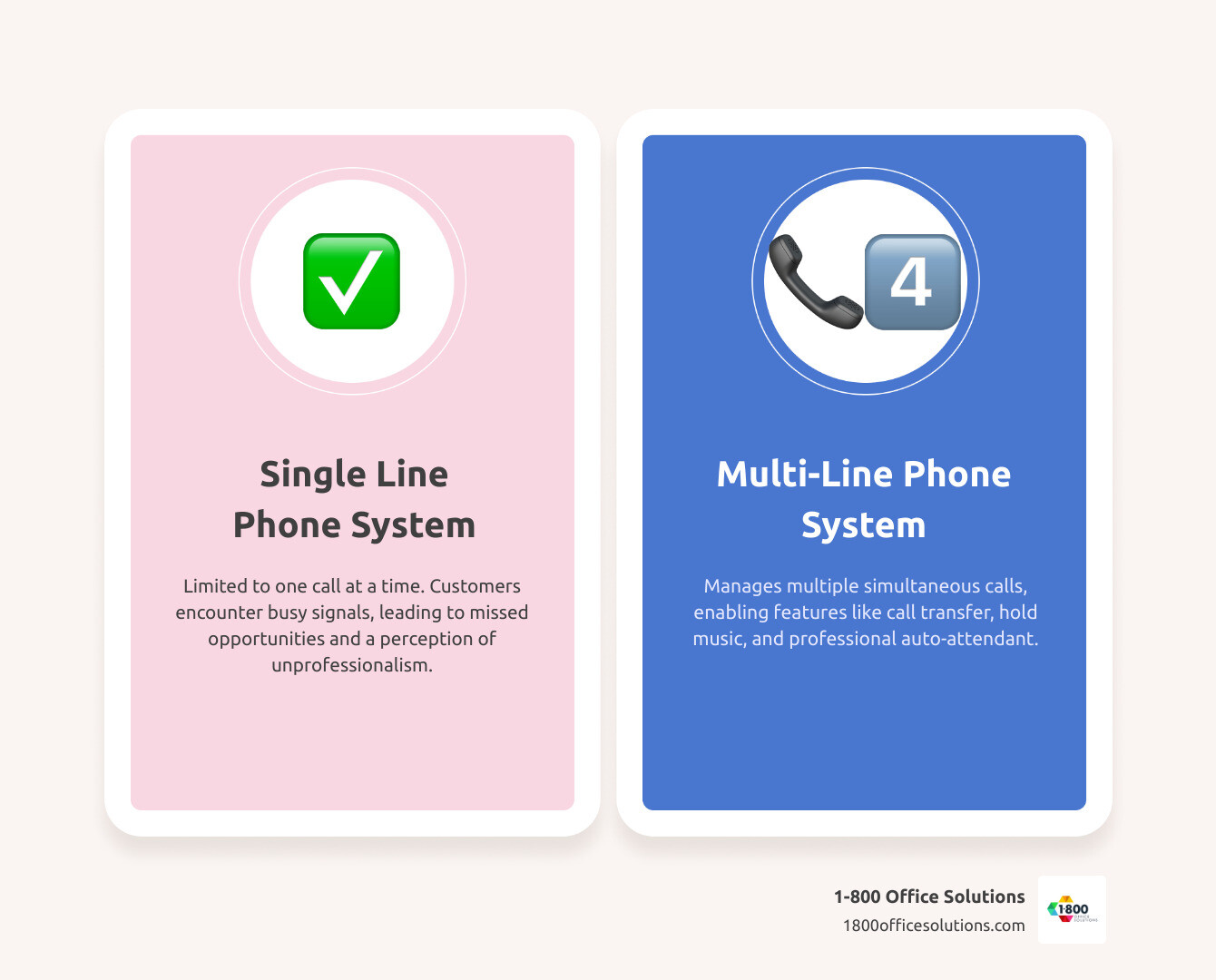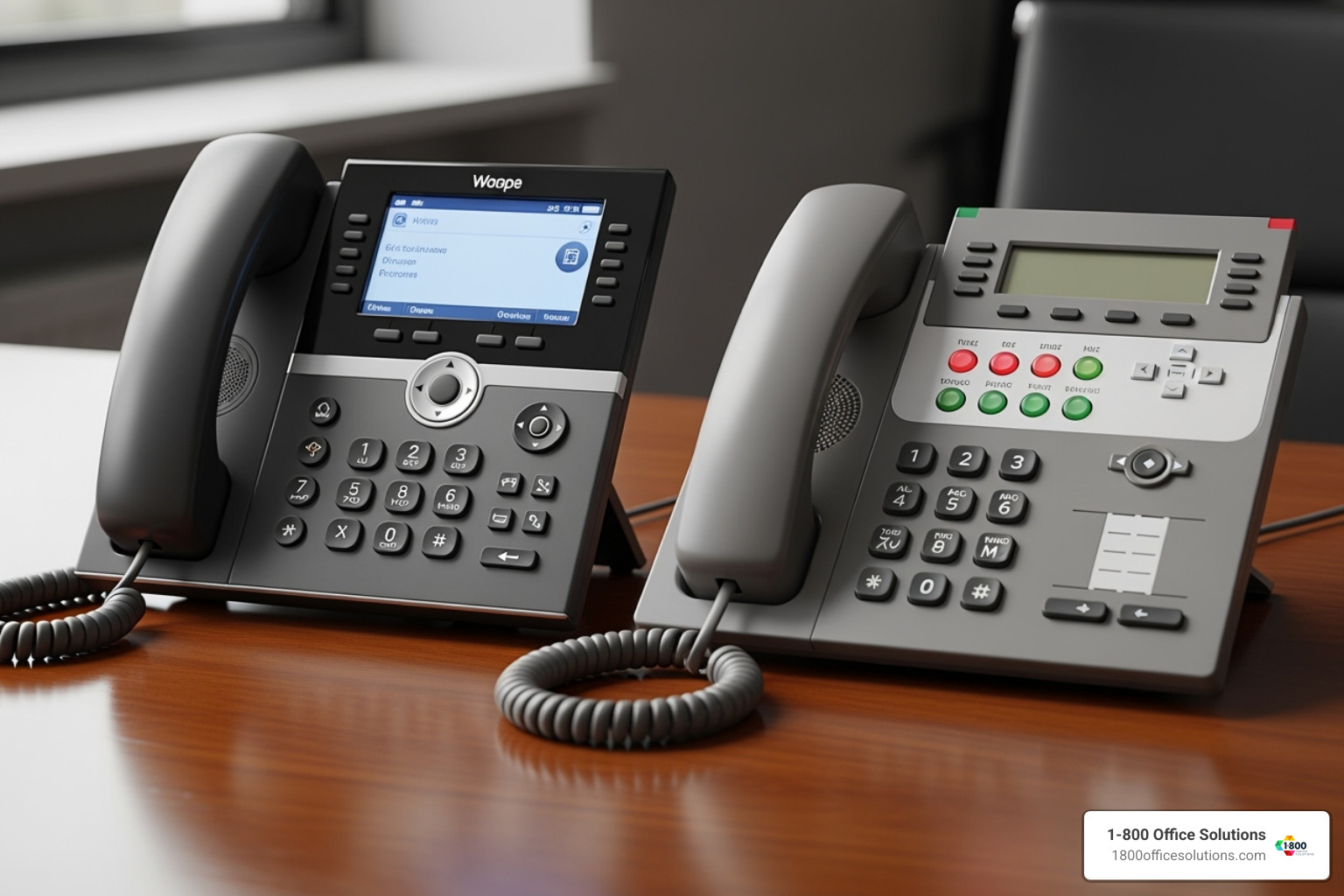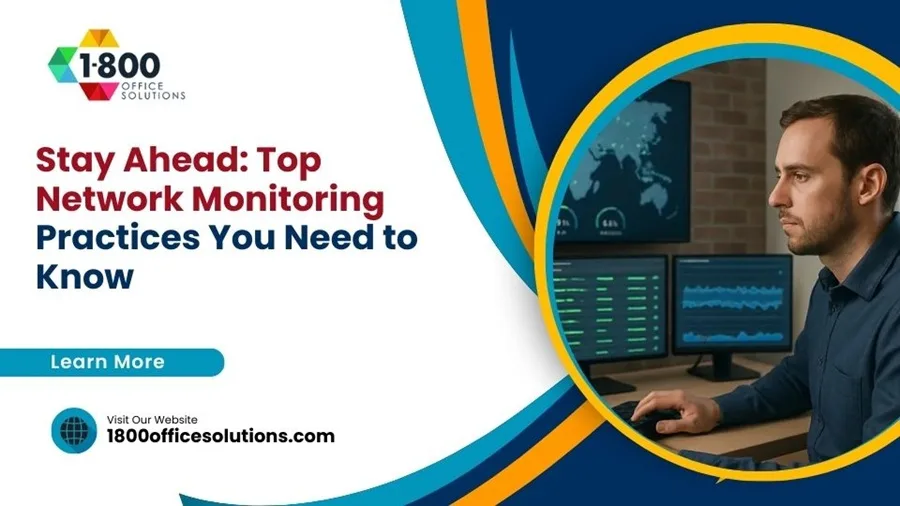The Fantastic Four: Best Multi-Line Phone Systems for Small Business
A 4 line phone system for small business is a communication solution that allows your office to handle up to four simultaneous phone calls using separate analog phone lines connected through your office phone equipment.
Quick Answer for Small Businesses:
- Traditional 4-Line Systems: Handle exactly 4 calls at once, use physical phone lines, require on-site hardware
- Modern VoIP Alternative: Handle unlimited calls, work over internet, include advanced features
- Best for: Businesses outgrowing single-line systems but considering if VoIP is better
- Typical Cost: $50-200+ per line monthly (traditional) vs. $20-40 per user (VoIP)
If you’re finding yourself juggling a growing number of calls daily, you’ve likely hit the wall that every expanding business faces. Your single phone line isn’t cutting it anymore.
When customers hear busy signals or get sent straight to voicemail, you’re not just missing calls – you’re missing opportunities. A busy signal sends a message that your business might be too small to handle their needs.
Four-line phone systems were the go-to solution for decades. They allowed small businesses to manage multiple calls, transfer customers between departments, and maintain a professional image. But here’s what’s changed: the technology landscape has shifted dramatically.
While traditional 4-line systems still exist, most businesses today are choosing cloud-based VoIP systems instead. These modern alternatives offer the same multi-line capabilities plus features that weren’t even possible with old-school phone systems – like mobile apps, video calling, and advanced call analytics.
The real question isn’t whether you need multiple lines (you probably do). It’s whether a traditional 4-line system or a modern VoIP solution makes more sense for your business in 2024.

4 line phone system for small business further reading:
What is a 4-Line Phone System and How Does It Work?
Think of a 4 line phone system for small business as your office’s personal telephone exchange. Instead of having one phone line that forces callers to wait or hear a busy signal, you get four separate lines that can all handle calls at the same time.
Here’s how it actually works: Four physical phone lines run into your office from your phone company. These lines connect to a central piece of hardware – either a Private Branch Exchange (PBX) or a Key System Unit (KSU). This hardware acts like a traffic controller, routing calls between your employees and managing who’s talking to whom.
A PBX is the more sophisticated option. It’s like having a mini phone company right in your office. When someone calls your main number, the PBX can automatically route them to the right person, put them on hold with music, or let them leave a voicemail. It handles all the behind-the-scenes work of connecting calls.
A KSU is simpler and more straightforward. With this system, each phone has buttons that light up to show which lines are active. Your employees can see at a glance which lines are busy and pick up available calls by pressing the right button.
When a customer calls your business, the call comes in on one of your four available lines. Your staff can answer it, put the caller on hold while they find information, transfer the call to someone else, or even bring multiple people together for a conference call. The beauty is that while one person is handling that call, three other conversations can be happening simultaneously on the other lines.
Before internet-based phone systems became popular, these traditional setups were absolutely essential for any business that wanted to look professional and handle more than one call at a time.
For more detailed information on traditional setups, you can explore More info about Small Office Phone Systems.
The Core Benefits for a Small Business
A traditional 4 line phone system for small business was a game-changer back in its heyday, and understanding why helps explain what modern businesses still need today.
The biggest win was improved call handling. Instead of customers getting a busy signal while you were helping someone else, they could actually get through. This meant you stopped losing potential sales just because you were already on the phone.
No more busy signals transformed the customer experience overnight. Nothing says “we’re too small for your business” quite like a busy signal. With four lines, customers could reach you even during your busiest periods, which made your small business feel much more established and reliable.
The professionalism factor was huge. Features like call transfer meant you could seamlessly connect customers to the right person instead of saying “let me have them call you back.” Internal intercoms let your team communicate without shouting across the office. These seemingly simple features made a world of difference in how customers perceived your business.
Many businesses used dedicated lines for different departments – one for sales, one for support, one for general inquiries. This organization helped calls get to the right person faster and made your business feel more structured and efficient.
For its time, a four-line system was surprisingly cost-effective. Rather than paying for four separate single-line phones scattered around your office, you got one integrated system that could do much more for roughly the same monthly cost.
Potential Drawbacks and Limitations
While traditional systems solved many problems, they came with baggage that feels especially heavy by today’s standards.
Hardware dependency was the biggest headache. Your phone system lived in boxes, cables, and physical handsets that could break, needed maintenance, and took up space. When something went wrong, you couldn’t just restart an app – you needed a technician.
Installation costs often shocked business owners. Running cables, setting up the hardware, and configuring the system required professional installation. Unlike today’s plug-and-play solutions, getting a 4 line phone system for small business up and running was a significant project.
The scalability limitations became frustrating as businesses grew. Need five lines? Too bad – you had to jump to eight. Need fifteen lines? You’d need multiple systems or a major upgrade. Growth happened in awkward chunks rather than smooth progression.
But the biggest limitation in today’s world is the lack of remote work support. These systems were physically anchored to your office building. If your sales rep was working from home or traveling to meet clients, they couldn’t access the phone system. In our increasingly flexible work environment, this restriction feels almost archaic.
Physical location restrictions meant your business communications stopped at your office door. There was no way to seamlessly extend your professional phone system to mobile devices, home offices, or satellite locations. Your phone system was as stuck in place as your filing cabinets.
Traditional vs. Modern: The 4 Line Phone System for Small Business in a VoIP World

Picture this: it’s 2024, and you’re still considering a traditional 4 line phone system for small business. It’s a bit like shopping for a horse and buggy in the age of cars – technically it’ll get you where you need to go, but you’ll be missing out on some pretty incredible advances.
The business communication world has been completely transformed. What used to require physical copper wires, bulky on-premise hardware, and expensive installation visits can now be set up in minutes with just an internet connection. Voice over Internet Protocol (VoIP) has essentially made traditional phone lines as outdated as fax machines (well, almost).
Here’s the fundamental difference: traditional systems rely on physical analog lines – actual copper wires running to your building. Modern VoIP systems convert your voice into digital data packets that travel over the internet. Instead of being limited to exactly four simultaneous calls, you’re now limited only by your internet bandwidth and service plan.
Think of it this way – traditional phone lines are like having four dedicated parking spots. VoIP is like having access to an entire parking garage that expands as needed.
| Feature | Traditional 4-Line System | Modern VoIP System |
|---|---|---|
| Technology | Analog (POTS lines), PBX/KSU hardware | Digital (Internet Protocol), cloud-based servers |
| Lines | Fixed 4 physical lines; limited to 4 simultaneous calls | Virtual lines; virtually unlimited simultaneous calls |
| Setup | Complex cabling, on-site hardware installation | Simple internet connection, plug-and-play IP phones |
| Cost | High upfront hardware/installation; per-line monthly fees | Low/no upfront hardware; per-user monthly fees (often includes unlimited calling) |
| Scalability | Scaled in fixed groups of 4; hardware upgrades needed | Easily scaled up/down with software changes; no hardware limits |
| Remote Work | Not supported; tied to office location | Fully supported via softphones, mobile apps, remote IP phones |
| Features | Basic (hold, transfer, intercom, conference) | Advanced (auto-attendant, CRM integration, call analytics, video conferencing) |
| Reliability | Susceptible to local power/line outages | Dependent on internet; often geographically redundant |
The Rise of VoIP and Unified Communications
VoIP technology has done something remarkable – it’s taken business communication beyond just phone calls. When your voice becomes digital data traveling over the internet, suddenly your phone system isn’t confined to that beige box in your office closet. It lives in the cloud, accessible from anywhere your team needs to work.
But here’s where it gets really interesting. Modern business communication isn’t just about voice anymore. Today’s systems bundle everything together in what’s called Unified Communications. Your phone system now seamlessly integrates voice calls, video conferencing, instant messaging, and even presence indicators that show when your colleagues are available.
Imagine being able to see that your sales manager is on a call, then sending them a quick message that gets delivered as a voicemail-to-email transcription. Or starting a voice call with a client that seamlessly transitions into a screen-sharing session. This integration isn’t just convenient – it makes your entire team more productive and responsive.
The Benefits of Unified Communications extend far beyond what any traditional 4 line phone system for small business could ever offer. Of course, with any technology transition, there can be hiccups. That’s why we’ve put together guidance on How to avoid common VoIP problems to help ensure your experience is smooth from day one.
Why Most Businesses are Making the Switch
The migration from traditional phone systems to VoIP isn’t happening because it’s trendy – it’s happening because the business case is overwhelming. Let’s talk numbers for a moment.
Cost savings are typically the first eye-opener. While traditional phone service can cost around $50 per line monthly (and that’s before long-distance charges), modern VoIP systems often run $20-40 per user with unlimited calling included. For a growing business, that’s the difference between spending $800 monthly on a traditional 4-line system versus $320 for four VoIP users with far more capabilities.
But the real game-changer is scalability on demand. Remember how traditional systems locked you into groups of four lines? VoIP systems laugh at such limitations. Need to add three new employees next month? No problem – just log into your admin portal and add three users. Seasonal business that needs to scale down in winter? Remove users with a few clicks. No technician visits, no new hardware, no waiting.
Advanced features that would have cost hundreds extra monthly with traditional systems now come standard. Auto-attendants, call routing, mobile apps, voicemail-to-email, and call analytics are just the beginning.
Perhaps most importantly, remote work capability isn’t an add-on feature – it’s built into the core design. Your employees can make and receive business calls from their smartphones, laptops, or home offices as if they were sitting at their desk. In today’s flexible work environment, this isn’t just nice to have – it’s essential for staying competitive.
Modern cloud systems can also queue up to 525 calls per line, ensuring you never miss an opportunity even during your busiest periods. Try doing that with a traditional 4 line phone system for small business.
If these advantages sound like exactly what your growing business needs, you might be Ready to Switch to VoIP Phones?.
Must-Have Features for Your Business Phone System
The features your phone system offers can make or break your business communication. Whether you’re considering a traditional 4 line phone system for small business or exploring modern VoIP alternatives, the right features will transform how your team handles calls and how professional you appear to customers.
Think about it this way: your phone system is often the first impression customers have of your business. A caller who gets stuck in an endless loop or can’t reach the right person quickly will form an opinion about your company before they even speak to a human.
Modern phone systems have evolved far beyond the basic hold-and-transfer functions of traditional setups. Today’s systems are designed to streamline call management, improve user experience, and boost your team’s productivity in ways that weren’t possible just a few years ago.
Key Features of a 4 line phone system for small business
The leap from traditional 4 line phone system for small business capabilities to modern VoIP features is dramatic. Where older systems might have offered basic call holding, today’s solutions provide sophisticated tools that can transform your customer interactions.
Auto-attendant functionality acts like having a professional receptionist available 24/7. When customers call, they hear a polished greeting that guides them exactly where they need to go – “Press 1 for Sales, 2 for Support” – ensuring no call gets lost or misdirected. This feature alone can make a small business sound much larger and more established.
Voicemail-to-email transcription eliminates the old ritual of dialing in to check messages. Instead, voicemails appear in your inbox as text, letting you quickly scan and prioritize responses. It’s a small change that saves significant time throughout your day.
Advanced call forwarding and routing goes well beyond simple call transfer. Modern systems can route calls based on time of day, caller ID, or even current call volume. You can set up round-robin distribution to ensure calls are spread evenly among your team, or use simultaneous ringing to make sure important calls always get answered.
Conference calling capabilities have become essential, with many systems supporting up to 6-way conversations. This makes impromptu team meetings or client discussions seamless, without needing separate conferencing services.
On-hold music and custom messaging keeps callers engaged instead of wondering if they’ve been disconnected. You can use this time to share information about your services or current promotions. VoIP’s Hold Message Options Are Easy to set up and customize.
Call recording provides valuable opportunities for training and quality assurance. Whether you record automatically or on-demand, these recordings can help improve customer service and ensure compliance when needed.
The fundamentals haven’t disappeared either. Caller ID, call waiting, speakerphone, intercom, and speed dial remain essential features, but they’re now improved with digital clarity and additional functionality that makes daily communication smoother.
Understanding the Costs
The financial picture between traditional and modern phone systems tells a compelling story. When evaluating a 4 line phone system for small business, looking beyond the sticker price reveals significant differences in long-term value.
Hardware investments vary dramatically between approaches. Traditional systems often require substantial upfront spending on PBX or KSU equipment, specialized multiline desk phones, and extensive cabling throughout your office. VoIP systems flip this model – while you can purchase dedicated VoIP phones (two-line models around $80, four-line phones starting at $160, and advanced models above $250), many businesses find they can use existing smartphones or computers as “softphones,” virtually eliminating hardware costs.
Installation expenses reflect this complexity difference. Traditional phone system installation typically runs between $154 and $658 due to the wiring and equipment setup required. VoIP installation is often as simple as plugging phones into your existing internet connection, with much of the configuration handled remotely by your provider.
Monthly service costs show the clearest contrast. Traditional POTS (Plain Old Telephone Service) lines can cost around $50 per line monthly, often covering only local calls. VoIP systems typically charge per user rather than per line, with plans starting as low as $18.95 per month per user – and that usually includes unlimited calling plus all the advanced features we discussed.
Maintenance considerations favor modern systems heavily. Traditional setups require on-site technician visits for repairs and upgrades, adding unpredictable costs to your budget. VoIP systems handle maintenance through software updates pushed automatically by your cloud provider, reducing both costs and headaches.
When you calculate the total cost of ownership over several years, VoIP systems typically deliver much better value. The combination of lower hardware costs, simpler installation, feature-rich monthly plans, and minimal maintenance creates compelling savings that only grow over time.
Is a Traditional Phone System Still a Viable Option?

Here’s the honest truth: for most businesses in 2024, a traditional 4 line phone system for small business isn’t the primary solution they should choose. But that doesn’t mean these systems have completely disappeared from the landscape.
Think of traditional phone systems like that reliable old pickup truck in your garage. The newer models have GPS, backup cameras, and heated seats, but sometimes you just need something that starts every time, no matter what. Traditional phone systems offer that same dependable simplicity.
The main advantage these older systems still hold is their rock-solid reliability. When your internet goes down and your VoIP system becomes as useful as a chocolate teapot, that traditional landline keeps humming along. There’s something reassuring about a phone system that doesn’t depend on your internet provider having a good day.
Security is another factor that keeps some businesses interested in traditional systems. While it’s more perception than reality these days, some business owners sleep better knowing their phone conversations aren’t traveling through the same internet pipes as their emails and web browsing.
When is a traditional 4 line phone system for small business still the right choice?
Despite VoIP’s overwhelming advantages, there are still specific situations where a traditional 4 line phone system for small business makes sense – though these scenarios are becoming increasingly rare.
If your business is located in an area with poor internet connectivity, you might not have much choice. Rural areas with spotty broadband or businesses in older buildings with infrastructure challenges sometimes find that reliable internet for VoIP is more wishful thinking than reality.
Some businesses with high-security requirements still prefer the perceived isolation of analog lines. While modern VoIP systems use sophisticated encryption that’s actually more secure than old-fashioned copper wires, the perception that “offline equals safer” persists in certain industries.
A traditional system can serve as an excellent backup solution for businesses where communication is absolutely critical. Think medical practices, emergency services, or businesses that simply can’t afford to lose phone service when the internet hiccups.
There’s also the simplicity factor. Some business owners genuinely prefer the straightforward nature of traditional systems. No software updates, no internet dependencies, no learning curve for new apps – just pick up the phone and dial.
Finally, budget constraints for initial hardware can sometimes make traditional systems appear attractive, especially if you can find used equipment. However, this is often false economy when you factor in long-term costs.
Scalability and Security Considerations
When it comes to growth, traditional systems face some pretty rigid limitations. These systems scale in groups of four. Need five lines? You’re buying eight. Need six? Still buying eight. It’s like buying shoes in bulk when you only need one pair.
This hardware-dependent approach means every expansion requires a technician visit, new equipment, and often some head-scratching about where to put it all. Compare that to VoIP, where adding a new “line” is literally a few clicks in a web browser, and the difference becomes stark.
On the security front, the reality is more nuanced than many people think. Traditional analog lines are indeed isolated from internet threats like hacking and malware. You can’t remotely access a copper wire the same way you might breach an internet connection.
However, modern VoIP systems use advanced encryption and security protocols that actually provide better protection than the “security through obscurity” approach of traditional lines. A landline might be safe from cyber attacks, but it’s still vulnerable to physical tapping or simple wire cuts.
The truth is, reputable VoIP providers invest heavily in security infrastructure that most small businesses could never afford to implement on their own. It’s a different type of security challenge, but one that’s actively managed by experts rather than left to hope and chance.
Conclusion: Choosing the Right Communication Path for Your Business
The journey through business phone systems – from the traditional 4 line phone system for small business to today’s sophisticated VoIP solutions – reveals a clear truth: your communication system should be your business’s secret weapon, not its limitation.
If you’ve made it this far, you probably already know that sticking with outdated phone technology is like trying to run a marathon in work boots. It might work, but why make things harder than they need to be?
The reality is straightforward. While traditional 4-line systems were in their time, they’re now the business equivalent of a flip phone in a smartphone world. The limitations we’ve discussed – from rigid scaling to zero remote work support – aren’t just inconveniences. They’re growth barriers that can cost you customers, frustrate your team, and ultimately hurt your bottom line.
Modern VoIP systems have fundamentally changed the game. They offer the reliability you need, the flexibility your team craves, and the professional features that make your small business sound like a Fortune 500 company. When a potential customer calls and hears a crisp auto-attendant routing them to exactly the right person, they’re not thinking “small business” – they’re thinking “these people have their act together.”
Future-proofing your communications means choosing a system that grows with your ambitions. Whether you’re planning to double your team next year, expand to multiple locations, or accept hybrid work, your phone system should enable that growth, not constrain it.
At 1-800 Office Solutions, we’ve helped countless businesses make this transition across Florida, North Carolina, Michigan, and beyond. We’ve seen how the right communication infrastructure transforms not just how businesses operate, but how they compete and succeed. Our expertise in VoIP phone systems means we don’t just sell you equipment – we design solutions that fit your unique needs and budget.
The choice isn’t really about traditional versus modern anymore. It’s about choosing a communication partner who understands that your phone system is the lifeline connecting you to every customer, every opportunity, and every success story yet to be written.
Ready to leave those communication limitations behind? For a modern, scalable solution that grows with your business, explore our business phone system offerings. Let’s build something great together.
How many simultaneous calls can a 4-line system handle?
The answer depends entirely on which type of system you're considering. A traditional 4 line phone system for small business can handle exactly four simultaneous external calls - no more, no less. It's right there in the name: four physical lines equals four concurrent conversations.
Modern VoIP systems that offer "4-line" functionality work completely differently. They're not actually limited by physical lines at all. Instead, they can handle significantly more simultaneous calls, depending on your service plan and internet bandwidth. Many VoIP providers can support dozens of concurrent calls on what they call a "4-line" plan, because they're really talking about user licenses rather than physical line restrictions.
This flexibility is one of the biggest reasons businesses are making the switch from traditional systems to cloud-based alternatives.Can I use a 4-line system for remote employees?
Here's where the difference between traditional and modern systems becomes crystal clear. Traditional 4-line systems are completely tied to your physical office location and simply won't work for remote employees. The phones need to be physically connected to the on-site hardware through cables and wiring.
If you have remote or hybrid team members, you'll need a cloud-based VoIP system instead. These modern solutions allow employees to make and receive business calls from anywhere with an internet connection. They can use a desk phone in the office, a computer softphone application, or even a mobile app on their smartphone - all while maintaining the same professional business number and access to company features like call transfer and voicemail.
This remote capability has become essential for most businesses, especially after the shift toward flexible work arrangements in recent years.What is the main difference in cost between a traditional 4-line system and a VoIP system?
The cost structures are fundamentally different, and understanding this can save you significant money over time. Traditional systems front-load the expenses with higher upfront costs for hardware purchases, professional installation, and system setup. Then you'll pay fixed monthly fees to your phone company for each physical line - often around $50 per line monthly, sometimes excluding long-distance charges.
VoIP systems typically flip this model entirely. They often have lower upfront costs since you can use existing computers and smartphones, or rent IP phones from your provider. The monthly pricing is usually per-user rather than per-line, starting around $20-40 per user and frequently including unlimited calling plus a comprehensive suite of advanced features.
When you calculate the total cost over two to three years, VoIP systems are generally much more cost-effective, especially when you factor in the additional capabilities you're getting. The savings become even more pronounced as your business grows, since adding new users to a VoIP system is much simpler and cheaper than installing additional physical lines.












